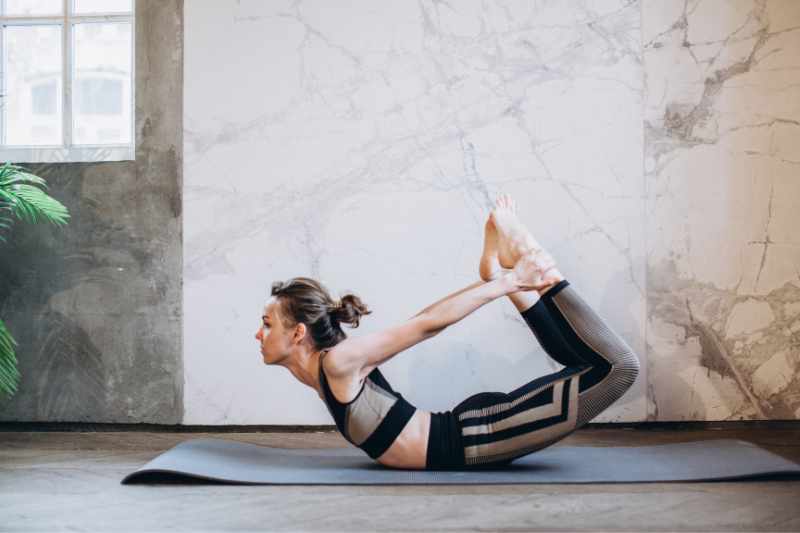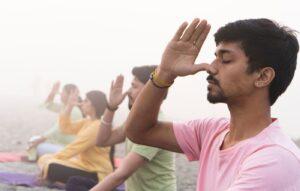Welcome to this thorough discussion of Dhanurasana, sometimes referred to as the Bow Pose. In this post, we’ll examine the proper techniques for doing Dhanurasana, go over all of its advantages, and go over some safety measures you should take when performing this energizing yoga pose. This manual will offer you invaluable insights to improve your yoga practice and your general well-being, whether you are a beginner or an advanced yogi.
What is Dhanurasana (Bow Pose)
Dhanurasana is a yoga stance that resembles the shape of a bow; it is derived from the Sanskrit terms “dhanu” (meaning “bow”) and “asana” (meaning “pose”). In this dynamic pose, the torso is bent backward and the ankles are held in place with the hands to resemble an archer’s bow poised to fire. Dhanurasana is acclaimed for its multiple physical, psychological, and spiritual advantages and is a crucial component of Hatha yoga.
Steps to Perform Dhanurasana (Bow Pose)
Consider performing Dhanurasana by following these detailed instructions:
Legs extended, feet hip-width apart, and arms laying beside your body, flat on your tummy.
Kneel down and extend your hands back to get hold of your ankles. Use a yoga strap or a towel to bridge the distance if you have trouble getting to your ankles.
Take a long, deep breath and raise your chest. Kick your feet into your hands at the same time to lift your knees and thighs off the ground.
Keep your gaze forward and your spine gently arched backward as you raise yourself higher.
Hold the position for 20 to 30 seconds while inhaling deeply and keeping your breathing rhythm consistent.
Release your hold on your ankles as you slowly exhale, then gently lower your legs and torso back to the mat.
Pro tip: Half Dhanurasana is a beginner-friendly variation of the pose where you just lift one leg at a time while keeping the other leg extended.
Benefits of Dhanurasana (Bow Pose)
There are numerous advantages of Dhanurasana, Bow Pose for the mind, body, and spirit. Consider some of the following benefits of include this posture in your regular yoga practise:
Strengthens the back muscles: The erector spinae, rhomboids, and trapezius are just a few of the back muscles that Dhanurasana is known for strengthening. Both back pain relief and posture improvement might result from this.
Increasing spinal flexibility: Dhanurasana’s deep backbend makes the spine more elastic and flexible. Regular practise helps promote a healthy range of motion and prevent spinal diseases.
The compression and relaxation of the abdomen during Dhanurasana massages the digestive organs, enhancing digestion, curing constipation, and toning the abdominal muscles. This posture stimulates the digestive system.
energy: Dhanurasana awakens the solar plexus, a crucial energy centre located behind the navel, which helps to reduce weariness and increase energy. The body is revitalised, energy levels are increased, and weariness is decreased by this stimulation.
Improves breathing and opens the chest: Dhanurasana increases deep breathing, expands the lung capacity, and enhances respiratory function. People with asthma or other respiratory disorders can benefit most from it.
Boosts blood circulation: Dhanurasana’s deep stretch encourages blood flow throughout the body, supplying various organs and tissues with oxygen and nourishment. The body’s natural healing processes are accelerated by improved circulation, which also encourages general vigour.
Precautions for Dhanurasana (Bow Pose)
Although Dhanurasana has several advantages, it is crucial to practise carefully and pay attention to the following safety measures:
Avoid if pregnant or recovering from recent abdominal surgery: Due to the extreme stretching of the abdominal muscles, Dhanurasana is not recommended for pregnant women or anyone who have recently had abdominal surgery.
Avoid if you have low back pain: It is best to avoid Dhanurasana or perform it under the supervision of a certified yoga instructor who can offer adjustments if you have acute or chronic low back discomfort.
Bow Pose should be avoided if you have high or low blood pressure because it can create fluctuations. Before attempting this posture, speak with your healthcare professional if you have high or low blood pressure.
Precautions for those with neck injuries or cervical spine conditions should be taken when performing Dhanurasana. Instead than putting stress on the neck, concentrate on the stretch in the back.
Prepare your body properly by warming it up with easy stretches and preparatory positions before tackling Dhanurasana. This lessens the possibility of damage and prevents muscle tension.
Observe your body: Pay attention to your body’s cues and refrain from pushing yourself above your limitations. Gently release the pose and seek advice from a yoga expert if you experience any sudden pain or discomfort.
Frequently Asked Questions About Dhanurasana (Bow Pose)
Is Dhanurasana suitable for beginners?
Yes, novices can perform Dhanurasana. Under the direction of a certified instructor, it is advised to begin with variations and gradually progress to the full expression of the posture.
Can Dhanurasana help with weight loss?
Dhanurasana is not a stand-alone weight loss treatment, but it can help with weight loss indirectly by enhancing digestion and increasing metabolism. For long-term weight management, a balanced diet and consistent exercise are essential.
How long should I hold Dhanurasana?
Initially, try to hold Dhanurasana for 20 to 30 seconds; as your practice improves, try to hold the pose for longer. Keep in mind to breathe steadily and pay attention to your body’s signals.
Can Dhanurasana help with menstrual discomfort?
By extending the abdominal muscles, increasing blood flow, and easing cramps, dhanurasana helps ease period discomfort. On days with high flow, it is best to avoid doing hard backbends.
Are there any preparatory poses for Dhanurasana?
Yes, exercises like Cobra Pose, Locust Pose, and Bridge Pose can help your body get ready for Dhanurasana.
What are the spiritual benefits of Dhanurasana?
The Manipura Chakra, the energy centre linked to inner strength and change, is thought to be opened during Dhanurasana. Regular practise helps foster inner fortitude, self-assurance, and a closer relationship with oneself.
Conclusion
The Bow Pose, or Dhanurasana, has numerous advantages for good physical, mental, and spiritual health. You may strengthen your back, become more flexible, improve digestion, enhance energy, and feel a sense of inner balance and harmony by including this asana in your regular yoga practice. Keep in mind to practise mindfully, respect your physical limitations, and, if necessary, seek advice from a certified yoga instructor. Utilise Dhanurasana’s strength to start your transformational journey to overall health and vitality.
Yoga in India – Multi Style Yoga Teacher Training in India – Ashtanga Yoga Teacher Training in India – Aerial Yoga Teacher Training in India – Ayurveda Yoga Teacher Training in India – Kundalini Yoga Teacher Training in India




